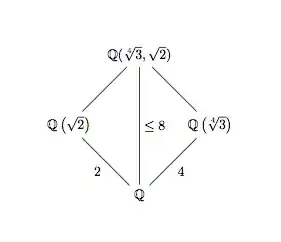I want to show that $\sqrt{2}\notin \mathbb{Q}(\sqrt[4]{3})$.
I think it would be easier to prove it using the following: $\mathbb{Q}\subset\mathbb{Q}(\sqrt{3})\subset\mathbb{Q}(\sqrt[4]{3})$. Then $\sqrt{2}\notin\mathbb{Q}(\sqrt{3})$ so $\sqrt{2}\in \mathbb{Q}(\sqrt[4]{3})\Longleftrightarrow \sqrt{2}=a+b\sqrt[4]{3}$, with $a,b\in\mathbb{Q}(\sqrt{3})$.
I tried simplifying the above equation, but I did not get anything.
